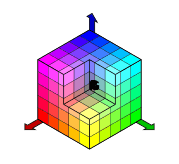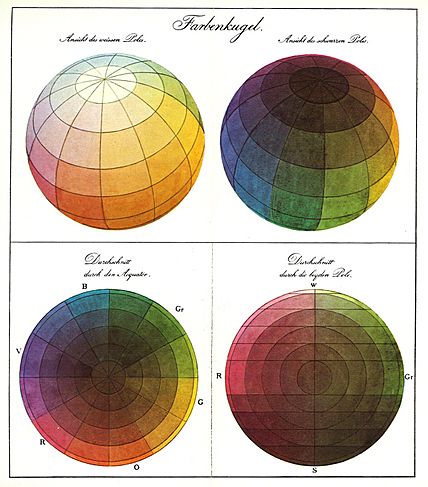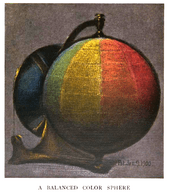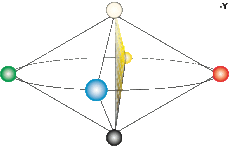Color model facts for kids
A color model is like a special math rule that helps us describe colors using numbers. Think of it as a recipe for a color, usually with three or four numbers. These numbers are called "color components" or "color channels." When we add details about how to use these numbers (like how bright the light is), we get a "color space."
Contents
How Colors Mix: Additive and Subtractive Models
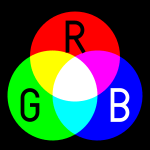 |
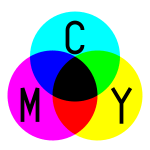 |
|
|
Additive color mixing
|
Subtractive color mixing
|
Color models can be split into two main types: additive and subtractive.
In additive color models, you start with darkness. When you mix different colored lights, you create new colors. For example, in the RGB system, mixing all the main colors of light (red, green, and blue) makes white. If there's no light at all, you see black. This is how screens like TVs and computer monitors work.
Subtractive color models are different. They work by taking away colors from white light. Imagine you have white paper. When you put ink on it, the ink soaks up some of the light. For example, if white light hits cyan ink, the ink absorbs red light, and you see cyan. This is how printing works.
Additive and subtractive color models are opposites!
RGB Color Model
Screens like televisions and computer monitors use the RGB color model. This model uses three main colors of light: red, green, and blue. Our eyes have special parts that see these three colors. When you mix these lights in different amounts, you can create almost any color a human can see.
RYB Color Model
The RYB color model stands for red–yellow–blue. This is an older model often used in art and design, especially with paints. It was important in art schools like the Bauhaus.
CMY and CMYK Color Models
When you print something, you usually use cyan, magenta, and yellow inks. These are the main colors for subtractive mixing. By putting these transparent inks on white paper, you can make a huge range of colors. Often, a fourth ink, black, is added. This helps make darker colors look better. This system is called "CMY" or "CMYK."
Here's how it works:
- Cyan ink absorbs red light but lets green and blue light pass through.
- Magenta ink absorbs green light but lets red and blue light pass through.
- Yellow ink absorbs blue light but lets red and green light pass through.
The white paper then reflects the light that wasn't absorbed back to your eyes.
Cylindrical Color Models
Many color models are shaped like cones, cylinders, or spheres. In these models, neutral colors (like grays) go from black at the bottom to white at the top, along a central line. The actual colors (like red, blue, green) are arranged around the outside, like angles on a circle. These types of models have been around since the 1700s!
Different artists and scientists have designed their own 3D color shapes. Many are shaped like a sphere. The color spheres made by Phillip Otto Runge and Johannes Itten are good examples. They inspired many other color systems.
HSL and HSV
HSL and HSV are two popular cylindrical color models. In both, the "hue" (the actual color, like red or blue) is an angle around the cylinder. Red is at 0 degrees, green at 120 degrees, and blue at 240 degrees. The central line in both models holds the "neutral" or "gray" colors. Black is at the very bottom, and white is at the very top.
Computer graphics experts created the HSV model in the 1970s. They wanted a way to mix colors that felt more natural than just using RGB numbers. The HSL model was also developed around the same time.
These models became very popular because they were easier to understand than raw RGB values. Also, converting colors between these models and RGB was super fast for the computers of that time. That's why you see these models used in almost all image editing and graphics software today.
Munsell Color System
Another important cylindrical color model is the Munsell color model, created in the early 1900s. Albert Munsell first thought of a spherical model. But he wanted to separate color into three parts: hue (the color itself), value (how light or dark it is), and chroma (how pure or strong the color is). After carefully measuring how humans see colors, he realized that colors don't fit into a perfect, symmetrical shape if you want them to look evenly spaced to our eyes. So, his system ended up looking like a "blob."
Munsell's system became very popular in America. It was used to describe the color of many things, from paints and crayons to electrical wires and even soil! This was because it was based on how people actually see colors. The colors in the Munsell Book of Color were very accurate and didn't fade over time. The only tricky part for computers is that Munsell colors aren't described by simple math formulas. Instead, you have to look them up in a table.
Natural Color System
The Swedish Natural Color System (NCS) is widely used in Europe. It's similar to another system called the Ostwald bi-cone. NCS tries to fit colors into a familiar shape based on how we experience them, rather than on scientific light measurements. Because of this, its "lightness" scale doesn't always match how light or dark a color truly seems to our eyes. This is because it tries to force bright colors like yellow, red, green, and blue into a flat plane.
Related pages
Images for kids
See also
 In Spanish: Modelo de colores para niños
In Spanish: Modelo de colores para niños


